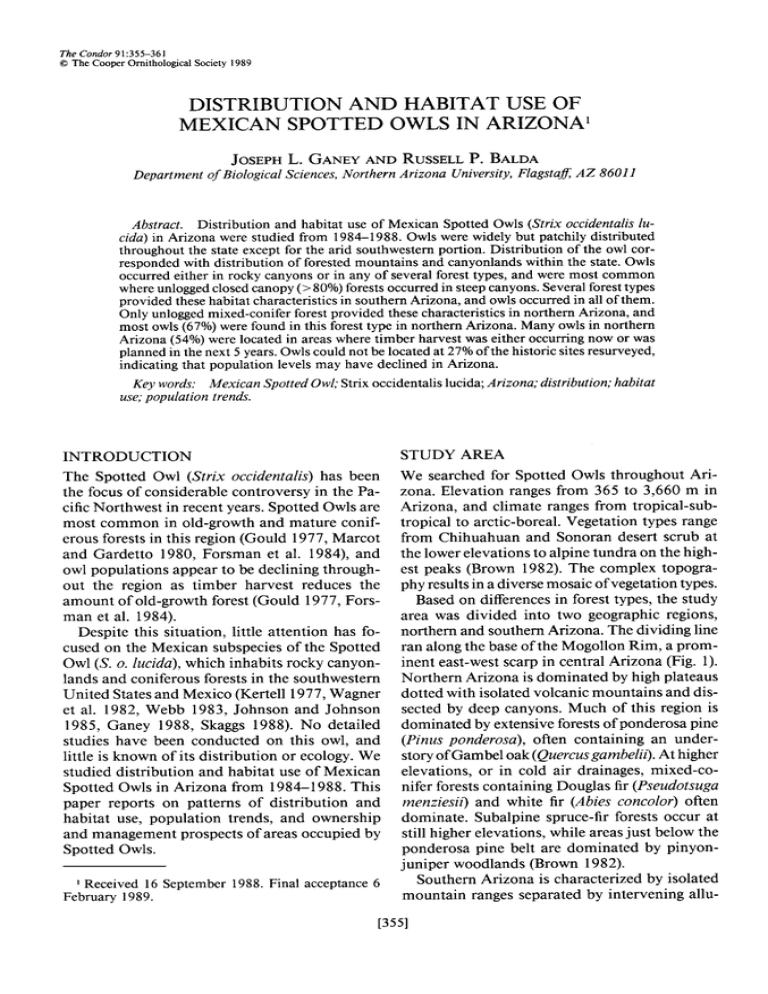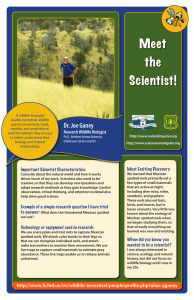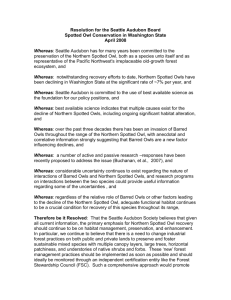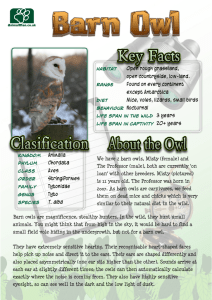DISTRIBUTION AND HABITAT USE OF
advertisement

The Condor 91:355-361 0 The CooperOrnithologicalSociety1989 DISTRIBUTION AND HABITAT USE OF MEXICAN SPOTTED OWLS IN ARIZONA’ JOSEPH L. GANEY AND RUSSELL P. BALDA Department of BiologicalSciences,Northern Arizona University,FlagstaE AZ 86011 Abstract. Distribution and habitat use of Mexican Spotted Owls (Strix occidentalislucida) in Arizona were studied from 1984-1988. Owls were widely but patchily distributed throughoutthe state except for the arid southwesternportion. Distribution of the owl correspondedwith distribution of forested mountains and canyonlandswithin the state. Owls occurredeither in rocky canyonsor in any of severalforest types, and were most common where unloggedclosedcanopy(> 80%) forestsoccurredin steepcanyons.Severalforesttypes provided thesehabitat characteristicsin southernArizona, and owls occurredin all of them. Only unloggedmixed-conifer forest provided thesecharacteristicsin northern Arizona, and most owls (67%) were found in this forest type in northern Arizona. Many owls in northern Arizona (54%) were located in areaswhere timber harvest was either occurringnow or was planned in the next 5 years.Owls could not be located at 27% of the historic sitesresurveyed, indicating that population levels may have declined in Arizona. Key words: Mexican SpottedOwl; Strix use;populationtrends. occidentalis lucida; Arizona; distribution;habitat INTRODUCTION STUDY AREA The Spotted Owl (Strix occidentalis) has been the focus of considerable controversy in the Pacific Northwest in recent years. Spotted Owls are most common in old-growth and mature coniferous forestsin this region (Gould 1977, Marcot and Gardetto 1980, Forsman et al. 1984), and owl populations appear to be declining throughout the region as timber harvest reduces the amount of old-growth forest (Gould 1977, Forsman et al. 1984). Despite this situation, little attention has focused on the Mexican subspeciesof the Spotted Owl (S. o. lucida), which inhabits rocky canyonlands and coniferous forestsin the southwestern United Statesand Mexico (Kertell 1977, Wagner et al. 1982, Webb 1983, Johnson and Johnson 1985, Ganey 1988, Skaggs 1988). No detailed studies have been conducted on this owl, and little is known of its distribution or ecology. We studied distribution and habitat use of Mexican Spotted Owls in Arizona from 1984-1988. This paper reports on patterns of distribution and habitat use, population trends, and ownership and management prospectsof areas occupied by Spotted Owls. We searchedfor Spotted Owls throughout Arizona. Elevation ranges from 365 to 3,660 m in Arizona, and climate ranges from tropical-subtropical to arctic-boreal. Vegetation types range from Chihuahuan and Sonoran desert scrub at the lower elevations to alpine tundra on the highest peaks (Brown 1982). The complex topography resultsin a diversemosaicof vegetationtypes. Basedon differencesin forest types, the study area was divided into two geographic regions, northern and southernArizona. The dividing line ran along the baseof the Mogollon Rim, a prominent east-west scarpin central Arizona (Fig. 1). Northern Arizona is dominated by high plateaus dotted with isolated volcanic mountains and dissectedby deep canyons. Much of this region is dominated by extensiveforestsof ponderosapine (Pinusponderosa),often containing an understoryof Gambel oak (Quercus gambelit]. At higher elevations, or in cold air drainages, mixed-conifer forestscontaining Douglas fir (Pseudotsugu menziesii)and white fir (Abiesconcolor)often dominate. Subalpine spruce-fir forests occur at still higher elevations, while areasjust below the ponderosa pine belt are dominated by pinyonjuniper woodlands (Brown 1982). Southern Arizona is characterized by isolated mountain ranges separated by intervening allu- I Received 16 September 1988. Final acceptance6 February 1989. 13551 356 JOSEPHL. GANEY AND RUSSELLP. BALDA : . .a. I . . Northern Arizona ” . +.~%BGSTQFF ST. JOHN’S 0 l . . PHOENIX0 . 3 :* SBFFORDl Southern Arizono reF’IGURE 1. Map of Arizona showinggeographic gionsrecognized (northernand southernArizona)and 160 locationswhereSpottedOwls werefoundduring thestudy.Alsoshownaretwolocationsin theHualapai Mountains(indicatedby triangles)whereSpottedOwls wereheardin 1978-1979,but werenot relocatedduring the study. vial valleys containing desert vegetation types. These mountains are dominated by mixed-conifer forests at high elevations. Ponderosa pine forests occur below the mixed-conifer, but are limited in extent and not nearly as predominant as in northern Arizona. Below the ponderosapine belt, extensive Madrean pine-oak forests occur (Brown 1982). These forestscontain an overstory of Chihuahua (P. leiophylla), Apache (P. engelmannig, ponderosa,and southwesternwhite pine (P. strobijknis), with an understory ofevergreen hardwoods(Brown 1982). This forestis thus quite different from the ponderosa pine-Gambel oak forests of northern Arizona. Below the pine-oak belt, encinal woodlands of low-growing evergreen oaks (Quercus spp.) are dominant. These woodlands are sometimes extremely dense, and replace the pinyon-juniper woodlands found at lower elevations in northern Arizona. Land-use history differs between regions. The mountains of southernArizona are managed primarily for range, watershed, and recreational purposes,and timber harvest has not been a major factor in altering vegetation patterns. In con- trast, extensive areas of old-growth coniferous forestshave been harvested in northern Arizona. Most recent logginghas been done using tractoryarding systems,and thus has been restricted to areaswith lessthan 40% slope. As a result, most remaining old-growth forests in northern Arizona occur on steep slopes or in roadless canyons. METHODS We located Spotted Owls by imitating their vocalizations and then listening for a response (Forsman 1983). Most surveys were conducted by stopping to call and listen for owls at calling stations spaced every 0.3-0.8 km along forest roads. We remained at these calling stations for 15 min or until a Spotted Owl responded. In roadless areas we conducted surveys by hiking ridgetops or canyon bottoms and calling every 30-40 sec. Surveys were concentrated in forests and canyonlands after initial efforts to locate Spotted Owls outside of such areas failed. All surveyswere conducted on calm nights between March and September, when Spotted Owls are most responsive (Forsman et al. 1984). Surveys were conducted from 1984-l 988, with most occurring in 1985. Most areas were surveyed only once. As a result, we undoubtedly failed to locate owls in some areas where they occurred. We mapped nocturnal owl locations based on a compassbearing and estimated distance to the calling owl. Accuracy of this method decreased as distance to the owl increased. Consequently, we revisited areasby day to locate roosting owls when possible. Roosting owls were located by calling during the day in areas where owls were heard at night, then homing in on a responding owl and locating it visually. Owl locations less than 2 km apart were assumed to represent the same pair unless owls could be heard in both areas nearly simultaneously or located roosting in both areas during the same day. This assumption may have causedus to underestimate the number of owls located. We used roosting locations to assesshabitat use, since owls may move long distancesat night in responseto calls (R. J. GutiCrrez, pers.comm.). We assignedeach owl location to a broad forest type, based on a visual inspection of the area occupiedby a roosting owl. Where roosting owls could not be located or time constraints prevented revisiting an area by day, forest type was classifiedas unknown. SPOTTED OWL DISTRIBUTION Six forest types were recognized, based on speciescomposition. Spruce-fir forest was dominated by Engelmann spruce(Piceaengelmannii) and/or subalpine fir (Abieslasiocarpa),while mixed-conifer forest was dominated by Douglas fir and/or white fir, often with a prominent component of pines (Pinusspp.) (Moir and Ludwig 1979). Forestswith > 50% ofoverstory treesconsisting of ponderosa pine were classifiedas ponderosa pine forest (after Old-growth Definition Task Group 1986). Similarly, forestswhere > 50% of overstory trees consisted of Apache and/or Chihuahua pines, with an understory of evergreen hardwoods,were classifiedas pine-oak forest. Forestsdominated by various evergreenoaks were classified as evergreen oak forest, while woodlands dominated by pinyon pines (Pinus spp.)and junipers (Juniperus spp.) were classified as pinyon-juniper woodland. Within theseforest types, deciduous riparian forests or Arizona cyarizonica)forests sometimes press (Cupressus occurred along canyon bottoms. Due to the limited extent of such habitats, owls occurring in these habitats were assignedto the surrounding forest type. We surveyed extensive areas of potential habitat throughout the state. Forest types were often patchy within the areas surveyed, and effective calling distance varied with topography, vegetation, and weather conditions. As a result, we were unable to determine the amount of each forest type surveyed. Therefore, the data presented describe observed patterns of habitat “use,” rather than habitat “selection” in the sense of use vs. availability. At each roost site, we noted whether or not timber harvest had occurred in the area. We referred to areas where harvest had not occurred as unloggedforest, rather than old-growth forest, sincewe lacked data on stand agefor many areas. Most such stands appeared to have some or all of the characteristicslisted in Old-growth Definition Task Group (1986) as being diagnostic of old-growth forests, however. We measured selected site characteristics at many roost sites (after Solis 1983). Only two characteristics are discussed here; others were summarized in Ganey (1988). Percent slope was measuredwith a clinometer. Two measurements were averaged, one taken upslope and one taken downslope from the roost. Percent canopy closurewas measuredwith a sphericaldensiometer. Four measurements were taken 5 m from the 351 roost tree in each cardinal direction, then averaged. Information on land ownership of areas occupied by Spotted Owls was obtained from U.S. Geological Survey topographic maps. Information on management “status” of occupied lands was obtained from U.S. Forest Servicebiologists. Six status categorieswere recognized, based on the amount of future habitat protection offered. Active timber saleswere defined as areas where timber harvest occurred during the courseof the study (1984-l 988). Planned timber sale referred to areas where harvest was planned within the next 5 years. This status could change at any time. Available timber lands were areasthat were open to harvest,but whereno harvestwasplanned within the next 5 years. Reserved lands included National Park Service lands, as well as National Forest lands classified as wilderness, primitive, or researchnatural areas.Private referredto lands in private ownership. RESULTS DISTRIBUTION Spotted Owls were found at 160 locations during the study (Fig. l), including pairs at 77 sites and single individuals at 83 sites. Repeated sampling would probably have revealed pairs at many of the latter sites (Forsman et al. 1984). Owls were widely but patchily distributed in Arizona, being found in all but the arid southwesternportion of the state.Owls were located only in forestedhighlands, at elevations ranging from 1,125 to 2,930 m, and their distribution reflected the availability of such areas. In southernArizona, we found owls at 84 sites. Owls were found in the Atascosa(Pajarito), Santa Rita, Santa Catalina, Patagonia, Whetstone, Galiuro, Huachuca, Chiricahua, Pinaleno, Superstition, Sierra Ancha, Mazatzal, and Bradshaw mountains. We were unable to locate owls in the basins and valleys between these ranges.Several other mountain ranges in this region were not surveyed, and Spotted Owls may be present in some or all of these ranges. In northern Arizona (n = 76 sites),concentrations of owls were found along the Mogollon Rim, in the White Mountains, and on the volcanic peaks near Flagstaff. Owls were located at scattered sites on the Kaibab Plateau and the Navajo Reservation. There are historic records from the Hualapai Mountains in northwestern 358 JOSEPH L. GANEY AND RUSSELL P. BALDA Arizona, but we were unable to locate owls there during the study. Many areaswere not surveyed, and Spotted Owls are undoubtedly more widespread than our data indicate. SPACING OF PAIRS We did not have sufficient data to estimate densities of Spotted Owls. We did estimate nearestneighbor distancesfor two areas in northern Arizona where we were confident we had located all resident pairs. Mean nearest-neighbor distances were 3.8 km in the San Francisco Peaks area (n = 7 pairs, SE = 0.42, range = 1.5-7.1 km) and 3.5 km in the White Mountains of eastern Arizona (n = 6 pairs, SE = 0.12, range = 2.7-6.1 km). The minimum known distance between two active nests in northern Arizona was 2.7 km. Nearest-neighbor distances were not computed for owls in southern Arizona, due to inadequate data. HABITAT USE Most Spotted Owls were located in deep canyons, particularly at the lower end of the owl’s elevational range. At elevations above 2,300 m owls appeared to be less dependent on deep canyons, and were found on mountain slopesas well. Owls were found in several forest types, ranging from coniferous forests to evergreen oak forest and associateddeciduous riparian forests.Owls were alsolocatedin canyonscontaining extensiverocky cliffs with potholes and caves; these structures were used for both roosting and nesting when available. In southern Arizona, owls were found at elevations ranging from 1,125-2,930 m. Habitat use was more variable in this region than in northern Arizona (Fig. 2). At elevations below 1,300 m owls were found in steep canyons containing cliffs and stands of evergreen oaks, Mexican pinyon (P. cembroides), and broadleaved riparian trees. Above 1,800 m owls were found primarily in mixed-conifer and pine-oak forests. Mid-elevation sites were variable, and included Arizona cypressforestsas well as all of the forest types mentioned above. The lower limit of Spotted Owl habitat appeared to coincide with the lower limit of the evergreen oak belt, while there did not appear to be a well-defined upper limit to Spotted Owl range in southern Arizona. A possible exception to this pattern was the Pinaleno Mountains, where spruce-fir forest occurred at the upper elevations. No owls were found in this forest type. Most owls were located in unlogged forests in southern Arizona. In the few caseswhere timber harvest had occurred, it consisted of light overstory removal through selective logging. In northern Arizona, Spotted Owls were found at elevations ranging from 1,525-2,925 m, and inhabited only two major forest types (Fig. 2). Most owls in northern Arizona (67%) were found in mixed-conifer forest. A few owls (5%) were located in ponderosa pine forest; none were located in spruce-fir forest. Pine-oak and evergreen oak forests did not occur in northern Arizona (Brown 1982). In general, the range of the Spotted Owl in northern Arizona appeared to coincide with the mixed-conifer zone between the ponderosa pine belt and the spruce-fir forest. Stands of unlogged forest were present at all but two of the owl sites(3%) in northern Arizona. Pocketsof mature timber remained after harvest at both sites, and these pockets of closedcanopy (> 80%) forest were used by roosting owls. Becausewe made no attempt to quantify the amount of each forest type surveyed, a potential for bias existed in analysis of habitats occupied. This potential was difficult to evaluate in southem Arizona, but was not suspectedto seriously bias the results presented here. All of the available forest types were surveyed for owls, owls were locatedin all foresttypesfrom the evergreen oak belt upwards, and we have no reasons to suspectthat the pattern of occupancy is greatly different from the pattern presented here. In northern Arizona, a mosaic of loggedridgetops and unlogged canyons occurred, and most surveys were conducted from roads through selectively-logged ponderosa pine forest on ridgetops. Since owl responseis likely to decreasewith distance, this should have created a bias toward location of owls in loggedponderosa pine forest. Thus, the fact that most owls in northern Arizona were found in unloggedmixed-conifer forest was unlikely to be due to survey bias. Despite the range of forest types occupied, certain features were shared by most sites. Most owls were found on steep slopes(X = 56%, SE = 6.2, n = 44) containing unlogged forests and/or rocky cliffs. The relative amount of forest and cliff varied among sites. At one extreme owls were located in canyonscontaining extensive forests and little or no cliff habitat. At the other extreme owls were locatedin canyonswith prominent cliffs where forest habitat was largely re- SPOTTED OWL DISTRIBUTION stricted to a narrow belt along the canyon bottom. Many siteswere intermediate between these extremes,containing cliffs and rock outcropsand extensiveforesttracts.Habitat diversity was often high, with different forest types forming a complex mosaic. Owls generally roosted on shaded cliffs (n = 5) or in unlogged stands with high canopy closure (X = 86%, SE = 1.3, y1= 39). Canopy layering was well-developed in mixedconifer and pine-oak forests, and most owls roosted in these types. Canopy layering was not well-developed in evergreen oak and ponderosa pine forests,and fewer owls roosted in these forest types (Fig. 2). LAND OWNERSHIP OF SITES WHERE OWLS WERE LOCATED Most owls (89%) were located on lands administered by the U.S. Forest Service, with the remainder located on Department of Defense, Indian Reservation, National Park Service, Bureau of Land Management, and private lands. This pattern was partly due to the fact that survey effort was greater on U.S. Forest Service lands, but there is no question that the types of habitats occupied by Spotted Owls in Arizona are concentrated on these lands. Few owls were located on reserved lands in Arizona. In northern Arizona, where most timber harvest occurs, 54% of the 76 known owl sites were in active or planned timber sales. Another 35.5% were on available timber lands where no timber harvest was planned in the next 5 years. Only 10.5% of the known sites were on reserved lands. SITE OCCUPANCY AND POPULATION TRENDS Site occupancy was monitored by checking 44 known owl sites at l- to 3-year intervals to determine if suchsiteswere continuously occupied. One or more owls were relocated at 42 of these sitesin one or more years. At the other two sites, occupancy was uncertain because survey effort was limited. Site tenacity was monitored for eight adult owls radio-tagged in northern Arizona during the summer of 1986. Seven of these owls still occupied the same home ranges in August 1987. The eighth owl died in November 1986, while still on its home range. To evaluate population trends, we resurveyed 15 historic Spotted Owl siteswhere information NORTHERN 5.3 (N q 76) % SOUTHERN Ponderoso 6 % ARIZONA 359 ARIZONA (N = 84) Pin Evergreen 10.7 Oak % Pine-ook 22 6 % FIGURE 2. Forest typesusedfor roostingby Spotted Owls in northern (n = 76 sites) and southern (n = 84 sites)Arizona. Geographicregionsand forest types are defined in the text. was sufficiently accurateto allow location of the original observation. Spotted Owls were found at 11 (73%) of these sites. No owls were located at the remaining four sites (27%) despite intensive searching.Two of these sites were in areas formerly occupied by extensive riparian forests (Bendire 1892) that had subsequently been converted to arid desert. At the third site, the owls formerly nested in a rocky grotto that subsequently became a heavily used recreational area. The fourth site had undergone no obvious habitat alteration and appeared to contain suitable habitat. DISCUSSION Spotted Owls appear to be most common in mountains and canyons containing mixed-conifer, pine-oak, and evergreen oak forests. They are also found in ponderosapine forestand rocky 360 JOSEPH L. GANEY AND RUSSELL P. BALDA canyonlands, and we cannot rule out the possibility that they occur occasionally in other habitats. Owl pairs occurred at intervals of 3-4 km in suitable habitat in northern Arizona. Marshall (1957) estimated that pairs occurred every 1.63.2 km in the mountains of southern Arizona, suggestingthat densities may vary among regions. More surveys and a better understanding of Spotted Owl habitat requirements and densities will be required to arrive at an accurate estimate of the number of Spotted Owls in Arizona. Spotted Owls are most common in unlogged old-growth forests in the Pacific Northwest (Gould 1977, Marcot and Gardetto 1980, Forsman et al. 1984). Most Spotted Owls in Arizona were also found in unloggedforests,often in steep canyons. In the few caseswhere owls were located in selectively-loggedforests, they roosted in remnant unloggedstands.This associationbetween Spotted Owls, steep canyons, and unloggedforestsalso appearsto hold in New Mexico (Johnsonand Johnson 1985, Skaggsand Raitt 1988). Mexican Spotted Owls do not appear to depend on old-growth foreststo the same extent as northern Spotted Owls, however, as they are sometimes found in rocky canyons with little forest habitat (Kertell 1977, Wagner et al. 1982, Johnson and Johnson 1985, this study). Barrows (198 1) suggestedthat Spotted Owls are intolerant ofhigh temperaturesand may require closedcanopy forests for protection from heat. This may explain the ability of owls in Arizona to inhabit deep canyons lacking extensive forests. In such casesthe cliffs and caves present may provide the necessaryrefuges from high daytime temperatures. Mixed-conifer forest appeared to be an important forest type for Mexican Spotted Owls. Fifty-one percent of all owls located in Arizona were found in mixed-conifer forest, even though this forest type covers only 3% of Arizona (Moir and Ludwig 1979). In New Mexico, Skaggsand Raitt (198 8) found significantly higher densities of Spotted Owls in mixed-conifer forest than in either ponderosa pine forest or pinyon-juniper woodland. Spotted Owls in northern Arizona were found primarily in unlogged mixed-conifer forest, and may require such forestswhere rocky canyons are lacking. Since 89% of northern Arizona owl sites were located on lands available for timber harvest, there appears to be a high potential for loss of Spotted Owl habitat in this region. Habitat loss due to timber harvest has been blamed for declining Spotted Owl populations along the west coast (Gould 1977, Forsman et al. 1984). Population trends are difficult to evaluate in Arizona, due to the short duration of this study and the lack of historic information. The fact that owls are now found primarily in remnant stands of unlogged forest on steep slopes suggeststhat timber harvest may have reduced the amount of suitable habitat. Habitat loss has certainly occurred where shady low-elevation riparian forestshave been eliminated, and we were unable to locate Spotted Owls at 27% of the historic sitesresurveyed. Thus, a decline in Spotted Owl numbers may already have occurred in Arizona. Habitat loss due to timber harvest could have severe consequencesfor Mexican Spotted Owls. This owl is already patchily distributed. Further fragmentation of suitable habitat could disrupt dispersal patterns, increase isolation of subpopulations, and reduce effective population size, thus increasing the likelihood of local extinction (Dawson et al. 1987, Lande and Barrowclough 1987). Unless land managersact quickly to protect Spotted Owl habitat, future management options could be lost, and Mexican Spotted Owls could be reduced in numbers or eliminated from large portions of their present range. ACKNOWLEDGMENTS We heartily thank the many professionalbiologistsand private citizens who assistedwith surveysor provided information about owl locations. We especiallythank G. A. Goodwin for moral and logisticsupportthroughout the study. Thanks also to G. C. Bateman and C. N. Slobodchikofffor their critical input. Comments by R. J. Gutierrez and an anonymous reviewer greatly improved the paper. This study was largely supported by the U.S. Forest Service, Southwestern Region, through a cooperative agreement with the Arizona Game and Fish Department, Nongame Branch. Special thanks to E. L. Fisher and R. L. Glinski for administering this agreement.Additional funding was provided b; the National Wildlife Federation, the Arizona Wildlife Foundation. and the Arizona Wildlife Federation LITERATURE CITED BARROWS, C. 1981. Roost selectionby Spotted Owls: an adaptation to heat stress.Condor 83:302-309. BENDIRE, C. E. 1892. Life histories of North American birds. U.S. Natl. Mus. Spec. Bull. No. 1. SPOTTED OWL DISTRIBUTION BROWN,D. E. [ED.] 1982. Biotic communities of the American southwest-United Statesand Mexico. Desert Plants 4: l-4. DAWSON,W. R., J. D. LIGON, J. R. MURPHY, J. P. MYERS,D. SIMBERLOFF, AND J. VERNER. 1987. Report of the Scientific Advisory Panel on the Spotted Owl. Condor 89:205-229. FORSMAN,E. D. 1983. Methods and materials for locating and studying Spotted Owls. USDA For. Serv. Gen. Tech. Rept. PNW- 162. PacificNW Res. Station. Portland, OR. FORSMAN,E. D., E. C. MESLOW,AND H. M. WIGHT. 1984. Distribution and biology of the Spotted Owl in Oregon. Wildl. Monogr. 87:1-64. GANEY,J. L. 1988. Distribution and habitat ecology of Mexican Spotted Owls in Arizona. MSthesis. Northern Arizona Univ., Flagstaff. GOULD,G. I. 1977. Distribution of the Spotted Owl in California. West. Birds 8: 13l-146. JOHNSON, J. A., ANDT. H. JOHNSON.1985. The status of the SpottedOwl in northern New Mexico. Contract No. 516.6-73-03. New Mexico Dep. Game and Fish. Santa Fe, NM. KERTELL.K. 1977. The SnottedOwl at Zion National Park, Utah. West. Birds 8:147-150. LANDE,R., AND G. F. BARROWCLOUGH. 1987. Effective population size, genetic variation, and their use in population management,p. 87-123. In M. E. Soule [ed.], Viable populations for conservation. Cambridge Univ. Press.,New York. MARCOT,B. G.. AND J. GARDETTO. 1980. Status of the Spotted Owl in Six Rivers National Forest, California. West. Birds 11:79-87. 361 MARSHALL,J. T., JR. 1957. Birds of the pine-oak woodland in southernArizona and adjacent Mexice. Pacific Coast Avifauna 32178-19: MOIR. W. H.. AND J. A. LUDWIG. 1979. A classificationof spruce-firand mixed-coniferhabitat types of Arizona and New Mexico. USDA For. Serv. Res. Pap. RM-207. Rocky Mtn. Res. Station. Fort Collins, CO. OLD-GROWTH DEFXXTIONTASKGROUP. 1986. Interim definitions for old-growth Douglas-fir and mixed-conifer forestsin the Pacific Northwest and California. USDA For. Serv. Res. Note PNW-447. Pacific NW Res. Station. Portland, OR. SKAGGS,R. W. 1988. Status of the Spotted Owl in southernNew Mexico: 1900-l 987. Contract No. 519-75-02. New Mexico Dep. Game and Fish. Santa Fe, NM. SKAGGS,R. W., AND R. J. RAITT. 1988. A Spotted Owl inventory on the Lincoln National ForestSacramento Division: 1988. Contract No. 5-5 16.676-17. New Mexico Dep. Game and Fish. Santa Fe, NM. SOLIS,D. M., JR. 1983. Summer habitat ecology of Spotted Owls in northwestern California. M.S.thesis. Humboldt State Univ., Arcata, CA. WAGNER,P. W., C. D. MARTI,ANDT. C. BONER. 1982. Food of the Spotted Owl in Utah. Raptor Res. 16: 27-28. WEBB,B. 1983. Distribution and nesting requirements of montane forest owls in Colorado. IV. Spotted Owl (5X.x occidentalis).Colo. Field Ornithol. 17:2-8.







